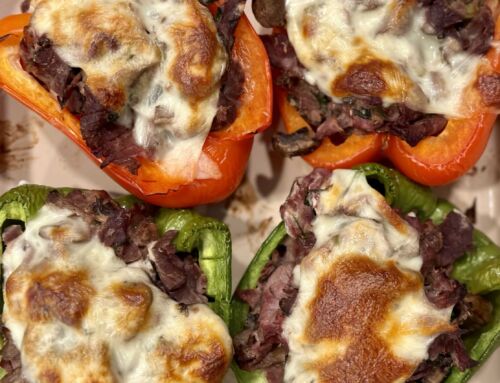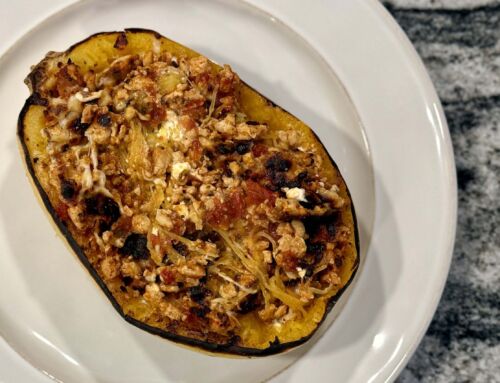‘Carnitas’ translates to ‘little meats’ and is Mexican cuisine’s version of pulled pork. Carnitas can be braised, simmered or fried. They are great on their own and are also used as a filling for tacos, enchiladas, burritos and so much more. The desired end result is meat that is easily shredded and a bit crispy.
I’ve been making Pork Carnitas in a slow cooker for years. What I didn’t realize was that I was missing the step of crisping the meat at the end. So while the slow cooker version is good, this recipe for Sous Vide Pork Carnitas is really good.
What is sous vide? It’s cooking meat ‘under vacuum’ or at a ‘low temperature for a long time’ in a water bath at a precisely regulated temperature. Essentially you’re cooking the meat at the temperature you want it to be when it’s done. For example, you’d typically bake chicken at 350°F until it reaches an internal temperature of 165°F. If you’re cooking chicken using the sous vide method, the water bath is 165°F the entire time it’s cooking.
Restaurants use this method to ensure that they have meat (say a filet mignon) at the right temperature that only needs a finishing sear before being served. It helps speed things up in the kitchen. For at home cooks, it’s a game changer. The meat comes out perfectly every time. There’s no more over cooked steaks or lamb chops in our house.
I resisted adding a sous vide immersion circulator to our kitchen for a long time. I thought it was a fad. I was wrong! If you don’t have one, please consider purchasing one. We have a Breville’s Joule Turbo Sous Vide. We liked our first one so much that we upgraded it to the Turbo option when it was released. And we gifted our original one (still in great shape) to Alex N because every college senior needs a sous vide in their kitchen.
For this recipe the sous vide method ensures that the meat cooks long and slow and is perfect when it’s done – all it needs is to crisp up under the broiler for a few minutes.
I wanted to make something new this past Cinco de Mayo and recalled my sister, Sarah S, talking about making carnitas and how much her family loved them. She shared this recipe from J. Kenji López-Alt. If you’ve never tried any of Lopez-Alt’s recipes, I highly recommend doing so. He’s all about the science behind cooking and puts a lot of thought and work into creating recipes. If you follow them, you really can’t go wrong.
While I’ve provided details on how to prepare these pork carnitas, I highly recommend reading more on Serious Eats about the science behind the temperature and timing. He provides three options for both and they all have their merit. I went with the 165°F for 12 to 24 hours option. I went for the full 24 hours knowing that with this method of cooking, it would not be overcooked. It’s safe to leave the sous vide cooking while you’re not in the house or sleeping. I started the carnitas at noon on Saturday and they were done the following day. The meat was moist and easy to shred, just like Lopez-Alt said it would be.
Since I had plenty of extra time while the pork was cooking, I made homemade Refried Black Beans from a batch of Dried Black Beans. These refried beans are cooked in just a bit of oil (not lard) with onion and cilantro. They have a fresh taste that you’re not used to with traditional refried beans found in many Mexican restaurants.
Pork carnitas, refried black beans, warm corn or flour tortillas, guacamole (or sliced avocado), fresh salsa, lime wedges and chopped fresh cilantro make for a perfect meal. The pork was great leftover as it was still crispy.
This is a great summer meal. While the pork may cook for a long time, it’s not heating up your kitchen and you only turn on the broiler for a few minutes.
| Sous Vide Pork Carnitas | Print |
- 4 pounds boneless pork shoulder, cut into 2-inch-thick slabs
- 1 medium onion, roughly chopped
- 6 medium cloves garlic, smashed
- 1 stick cinnamon, broken into 3 to 4 pieces
- 2 bay leaves
- 1 medium orange (with peel)
- Kosher salt
- Serve with warm corn or flour tortillas, guacamole (or sliced avocado), fresh salsa, lime wedges and chopped fresh cilantro
- In a large bowl, combine pork, onion, garlic, cinnamon stick pieces and bay leaves.
- Cut the orange into quarters and squeeze juice into the bowl. Add the orange quarters to the bowl after squeezing.
- Season generously with Kosher salt and toss to combine.
- Transfer contents to a vacuum bag and seal (see Notes). Ensure that the pork slabs are in one layer.
- Set up your sous vide immersion circulator in a container large enough to hold the pork so it will always be submerged. You may need a larger container than you normally use.
- Select your desired temperature (see Notes) and preheat the water bath.
- Add the pork bag to the water bath and select your desired cooking time (see Notes).
- Ensure that your pork bag is fully submerged in the water. Given that you are heating this for many hours, water will evaporate, so cover your container with a lid or aluminum foil. Check the water supply every few hours and add additional hot tap water as needed.
- When the pork is cooked, remove it from the water bath.
- Preparing the pork in advance: If you are cooking the pork in advance and don’t plan to serve it the same day, cool the pork to room temperature directly in the bag or chill in an ice bath, then transfer the bag to the refrigerator or freezer. Pork can be refrigerated for up to 5 days, or frozen for up to 2 months. You can rewarm the pork by returning the bag to a water bath set to 165°F for 1 hour. Warming the pork makes it easier to shred. Proceed to the shredding step below.
- Finishing the pork the same day: Open the bag and use tongs to remove the pork slabs to a large bowl. Discard what remains in the bag (alternatively, save the liquid for soup).
- When the pork is cool enough to handle, shred meat roughly using 2 forks or your fingers. Discard any large pieces of fat. Cover the bowl and refrigerate the pork for a few hours or move onto the broiler step immediately.
- When ready to serve, transfer the pork to a large rimmed baking sheet covered in aluminum foil.
- Adjust the oven rack to 3 inches below the broiler element. Preheat the broiler to high
- Place the pork under broiler and cook, using a spatula or tongs to flip pieces occasionally, until meat is browned and crisp on most sides, about 10 minutes total. Alternatively, working in batches, heat carnitas in a cast iron or nonstick skillet over medium heat, turning occasionally, until crisp, about 10 minutes.
- Serve pork carnitas warm with warm corn or flour tortillas, guacamole (or sliced avocado), fresh salsa, lime wedges and chopped fresh cilantro
* I highly recommend sealing the pork in a vacuum seal bag for this recipe. If you can’t vacuum seal the pork, then double-bag two large heavy-duty zipper-lock bags and place the pork in them.
* Temperature and time options – 145°F for 24 to 36 hours for very tender and moist but not very shreddable – better for cubing or searing as slabs | 165°F for 12 to 24 hours for moist and easy to shred with your hands or forks | 185°F for 8 to 16 hours for a traditional texture that shreds naturally.
Source: Variation on recipe from J. Kenji López-Alt for Sous Vide Carnitas for Tacos (Crispy Mexican-Style Pulled Pork) on Serious Eats







I love this — like you, I’ve used the slow cooker for years. This is exciting! Thanks.
David – I know you’ll like this recipe as it’s well tested. I hope you have a sous vide.